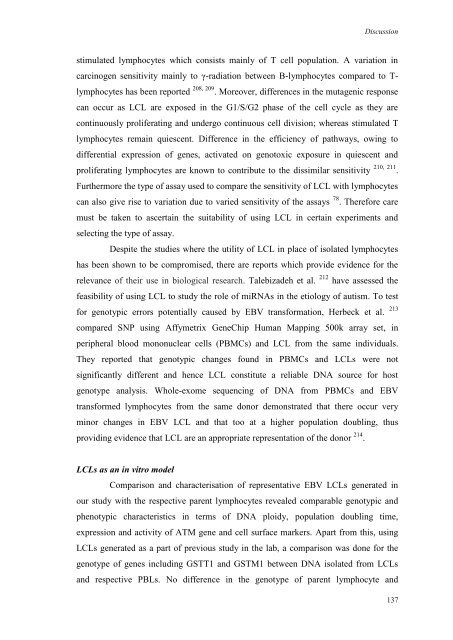LIFE09200604007 Tabish - Homi Bhabha National Institute
LIFE09200604007 Tabish - Homi Bhabha National Institute
LIFE09200604007 Tabish - Homi Bhabha National Institute
Create successful ePaper yourself
Turn your PDF publications into a flip-book with our unique Google optimized e-Paper software.
Discussion<br />
stimulated lymphocytes which consists mainly of T cell population. A variation in<br />
carcinogen sensitivity mainly to γ-radiation between B-lymphocytes compared to T-<br />
lymphocytes has been reported 208, 209 . Moreover, differences in the mutagenic response<br />
can occur as LCL are exposed in the G1/S/G2 phase of the cell cycle as they are<br />
continuously proliferating and undergo continuous cell division; whereas stimulated T<br />
lymphocytes remain quiescent. Difference in the efficiency of pathways, owing to<br />
differential expression of genes, activated on genotoxic exposure in quiescent and<br />
proliferating lymphocytes are known to contribute to the dissimilar sensitivity 210, 211 .<br />
Furthermore the type of assay used to compare the sensitivity of LCL with lymphocytes<br />
can also give rise to variation due to varied sensitivity of the assays 78 . Therefore care<br />
must be taken to ascertain the suitability of using LCL in certain experiments and<br />
selecting the type of assay.<br />
Despite the studies where the utility of LCL in place of isolated lymphocytes<br />
has been shown to be compromised, there are reports which provide evidence for the<br />
relevance of their use in biological research. Talebizadeh et al. 212 have assessed the<br />
feasibility of using LCL to study the role of miRNAs in the etiology of autism. To test<br />
for genotypic errors potentially caused by EBV transformation, Herbeck et al. 213<br />
compared SNP using Affymetrix GeneChip Human Mapping 500k array set, in<br />
peripheral blood mononuclear cells (PBMCs) and LCL from the same individuals.<br />
They reported that genotypic changes found in PBMCs and LCLs were not<br />
significantly different and hence LCL constitute a reliable DNA source for host<br />
genotype analysis. Whole-exome sequencing of DNA from PBMCs and EBV<br />
transformed lymphocytes from the same donor demonstrated that there occur very<br />
minor changes in EBV LCL and that too at a higher population doubling, thus<br />
providing evidence that LCL are an appropriate representation of the donor 214 .<br />
LCLs as an in vitro model<br />
Comparison and characterisation of representative EBV LCLs generated in<br />
our study with the respective parent lymphocytes revealed comparable genotypic and<br />
phenotypic characteristics in terms of DNA ploidy, population doubling time,<br />
expression and activity of ATM gene and cell surface markers. Apart from this, using<br />
LCLs generated as a part of previous study in the lab, a comparison was done for the<br />
genotype of genes including GSTT1 and GSTM1 between DNA isolated from LCLs<br />
and respective PBLs. No difference in the genotype of parent lymphocyte and<br />
137

















